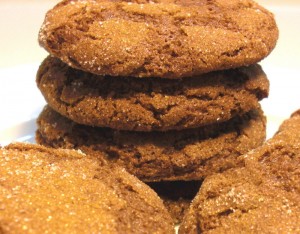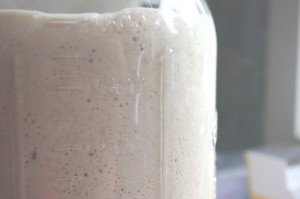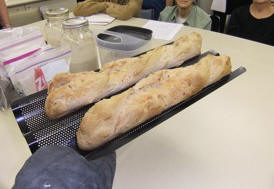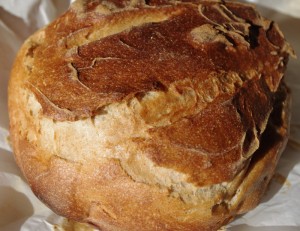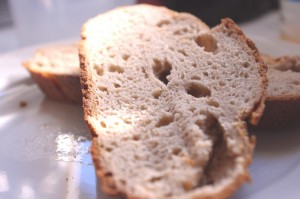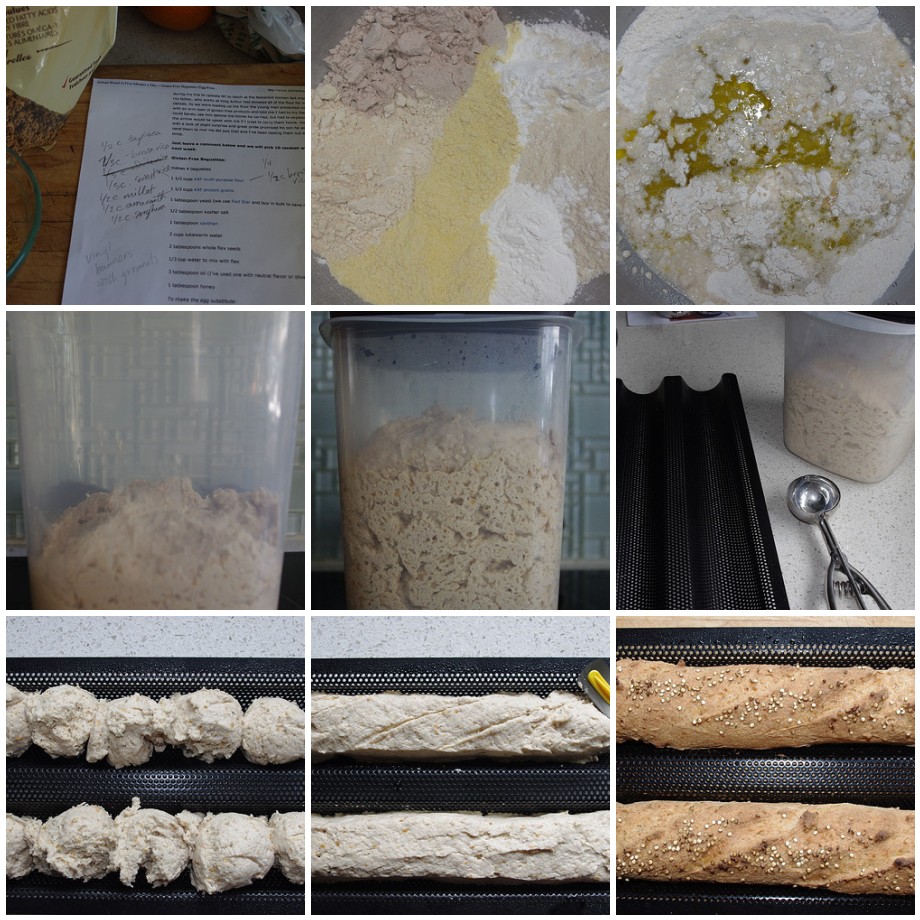I know I promised the gluten-free bagel recipe, but am still double checking my measurements before putting the recipe out there for y’all. In the [...]]]>
I know I promised the gluten-free bagel recipe, but am still double checking my measurements before putting the recipe out there for y’all. In the meantime, here’s a little gluten-free, dairy-free treat to get you feeling all Yuletide-ey. These are simple enough that you can do all the mixing by hand — the Earth Balance softens to a quite workable texture. You can also use butter if you are eating dairy — just make sure its softened at room temperature for a while.
These are rolled in sugar and get a nice crackled top when baked. Try them out — you won’t believe they’re not gluten!
Gluten-free Molasses Spice Cookies
Mix together dry ingredients with a whisk
- 1/2 cup sorghum flour
- 1/2 cup teff flour
- 1/2 cup tapioca starch
- 1/2 cup cornstarch
- 1 tsp. cinnamon
- 1 1/4 tsp. ground ginger
- 1 tsp. allspice
- 1/4 tsp. ground cloves
- 1/4 tsp. ground black pepper
- 1 tsp. xantham gum
- 1 tsp. baking soda
- 1/2 tsp. baking powder
- 1/4 tsp. salt
- 1/2 cup Earth Balance shortening
- 2/3 cup sugar
- 1/4 cup cooking molasses
- 1 egg
Cream together the Earth Balance and sugar. Add in the cooking molasses and the egg and mix thoroughly before adding the dry ingredients.
Drop by tablespoons and roll in sugar before placing on a parchment-lined cookie sheet. Bake at 350 for 12-13 minutes.
]]>I was also [...]]]>
I was also invited to attend the most recent Victoria Chapter meeting of the Canadian Celiac Association to do a bread baking demo, where we walked through using the wild yeast starter for sourdough baguettes. When you combine the use of the wild yeast starter, with basic ratios, and opt to weigh your ingredients, the baking is actually much more intuitive than conventional gluten-free bread baking, and is quite a bit more forgiving in terms of temperature variations, rise times etc. Here`s 2 baguettes fresh from the oven, where we were`t quite sure how well calibrated the oven was, and had to cut the rise time short!
As I noted in the last post, Dr. Jean Layton has also been working on her sourdough recipe, and just posted hers today on her recipes blog. It`s always interesting to see what different approaches different gluten-free bakers opt to take — she has achieved a fabulous result with a lower hydration level (somewhere closer to the typical 67% hydration level you would get with a 1-2-3 sourdough formula).
When I was playing around with the sourdough starter, I opted for a higher hydration level, which allows you a shorter rise time (good if you`re in a hurry) because the dough is considerably softer, but I also started with a smaller amount of starter.
So here you go: This recipe makes both baguettes and boules. If you opt to make 1 large boule, you can cut the liquid down by about 1/4 cup. Mound the dough onto a piece of parchment, smooth into a round boule shape and let rise until nearly double in size. While the boule is rising, preheat the oven AND a lidded cast-iron dutch oven to 450 degrees. Slash the dough before baking, plop the dough on the parchment into the hot pan, cover with the lid and bake in the oven at 450 degrees for 25 minutes. Remove the lid, reduce the oven to 400 degrees and cook for another 30-35 minutes, until the internal temperature reaches 205 degrees.
Gluten-free Wild Yeast baguettes (Printer friendly recipe)
1-2 hours before you plan to bake, remove the “mother” starter from the fridge, mix together your “starter” for the recipe …
- 1/2 cup sourdough starter
- 1/2 cup water
- 1 Tablespoon potato flour (NOT starch)
Let sit, covered for 1 –2 hours to get the wild yeast going again.
In a medium bowl, combine dry ingredients and whisk well
- All of the starter you made earlier
- 1 Tablespoon honey
- 1 Tablespoon neutral flavoured oil
- 1 1/2— 1 3/4 cup water
Add the dry ingredients to the mixer, and mix at medium speed for at least 3 minutes until the dough becomes smooth
- 200 grams Jean’s sourdough flour*
- 50 grams cornstarch
- 50 grams tapioca starch
- 2 1/4 teaspoons xantham gum (or guar gum)
The dough will be very soft and billowy, and should be wet enough to allow it to rise easily. If it looks like it needs more water, add 1-2 T at a time.
Use a scoop to place the dough in a greased baguette pan. Smooth out the baguettes and slash. Let sit, covered for at least 1 hour, and up to 4 hours. You can also raise the baguettes overnight in the fridge for further development of the flavours.
20 minutes before baking, preheat oven to 425 degrees.
Bake for 30-35 minutes
* Sourdough flour blend (makes 1 large batch of flour, weight, 145 grams per cup)
- 583 grams brown rice flour
- 583 grams sorghum flour
- 583 grams millet flour
- 290 sweet rice flour
- 74 grams garfava flour
- 155 grams white bean flour (I switched the proportions of the garfava/white bean flours)
To make a starter: Mix at 100% hydration (equal parts water and flour), let sit 2 days at room temp until it starts to bubble.
After 2 days, you can start to feed the starter — approximately 1/4 the volume of the total starter. (e.g. if the starter is 2 cups, feed it with 1/4 cup flour + 1/4 cup water. Every 3rd feed or so, adding 1T potato flour will help promote active yeast growth in the starter.
If you keep the starter in the fridge, feed it approximately 1 x per week, or every time you take it out to bake. The starter can be used for breads, but can also be used to leaven other things from muffins to pancakes — just bear in mind that your final product will have the “tang” of the wild yeast starter.
As always, if it has yeast in it, we send it over to Yeastspotting, that bloggy repository of all things yeasty and baked! If you haven`t checked it out, its very inspiring to check out the amazing baking!
]]>I’ve also been noodling around with sourdough starters, aiming for creating a nice wild-yeast starter that could be used for slow-rise breads with that perfect tang to them, and ideally increased digestibility due to all that enzymatic breakdown that happens with the delayed ferment.
One of the bigger issues with many of the gluten-free whole grain options out there, are that they bake up quite densely — not really a desirable texture in something you are likely to be eating on a daily basis. I’ve tried quite a few options, including the GEMS flour blends developed by Wendy Turnbull, and found that while the taste is quite good, both hub and I weren’t really keen on the texture — a lot of these flour blends, the GEMS included, rely very heavily on brown rice flour, which, even when finely milled, don’t result in the crusty exterior I know and love in breads, and when not superfinely milled, can be a bit sandy in texture.
So when last month, Dr. Jean Layton put up a post about her sourdough starter, I pulled out the mason jars and got burbling!!! On closer inspection, she has put a lot of work into developing her sourdough flour blend, to have the same composition as hard white winter wheat! and while it had some brown rice flour in it, it also has other flours like sorghum and millet and sweet rice, and some garfava and white bean for protein! I figured since I had mixed up a few kilos, that I’d also try it out in an egg and dairy-free loaf form, and see what the result was like.
As a little teaser, this is the interior of one of the FAIL loaves!
The interior is moist yet tender, and the crust … well its CRUSTY!!!!
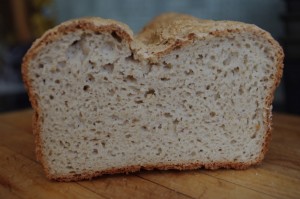
I’ll post pictures and a recipe for the SUCCESS version tomorrow! From the FAIL loaf, we made a few tweaks, adjusted the hydration levels a bit, switched to chia seeds, and played with the baking temperature — This is a more nutritious, plain-jane loaf that will satisfy!!! Stay tuned ![]()
This recipe is gluten-free, and while it looks like it contains a few steps, [...]]]>
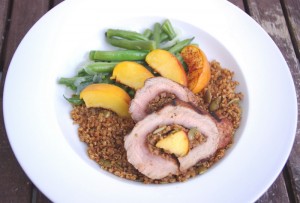 This recipe is gluten-free, and while it looks like it contains a few steps, once all the ingredients are ready to go, it comes together fairly quickly … and you get to resurrect your boy-scout skillz when you truss the pork! Pork these days is a fairly lean, mild flavoured meat, and makes a good alternative (for those who eat meat) from chicken.
This recipe is gluten-free, and while it looks like it contains a few steps, once all the ingredients are ready to go, it comes together fairly quickly … and you get to resurrect your boy-scout skillz when you truss the pork! Pork these days is a fairly lean, mild flavoured meat, and makes a good alternative (for those who eat meat) from chicken.
The quinoa used in the stuffing does double duty as a “starch” side dish, so all you need to pull of a complete meal is pair with a veggie or salad — you could even go crazy with a spinach/peach/red onion salad if you found some nice peaches!
Pork Tenderloin Stuffed with Spiced Quinoa (printer friendly recipe)
Please remember that Maple Leaf is continuing to run this contest for the next month or so, and you can vote daily for the recipes you “like”. Should I be fortunate enough to win, I’ll be donating the winnings to the Mustard Seed food bank here in Victoria.
You can find the contest at the Maple Leaf Prime page on Facebook. Thanks for your support!
( EAVB_RCCOLGZPDW )
]]>I’ve been playing around with the gluten-free recipes from Healthy Bread in 5 Minutes per day. Zoe Francois and Jeff Hertzberg have done a great job of providing whole grain and gluten-free options for their Artisan Bread in 5 minutes per day method.
Simply put, this method is great for families and households where you would like [...]]]>
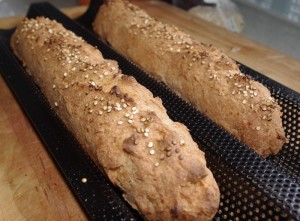
I’ve been playing around with the gluten-free recipes from Healthy Bread in 5 Minutes per day. Zoe Francois and Jeff Hertzberg have done a great job of providing whole grain and gluten-free options for their Artisan Bread in 5 minutes per day method.
Simply put, this method is great for families and households where you would like to be able to make bread with a minimum of fuss. It involves mixing larger batches of dough, and letting a long, cool, delayed fermentation do the rest of the work for you. For wheat-based breads, this method is great, as it develops the gluten structure slowly, but thoroughly, and has the added benefit of the enzymatic reactions typical of a delayed ferment. Obviously, with gluten-free breads, there is no need to develop the gluten, but this method is a great one nonetheless, for the convenience AND for the flavour development
While I’ve been doing my own noodling around with these recipes to make them egg and dairy-free, a while back, I noticed that ABin5 put up their own version of an egg-free, gluten-free version, which was also whole-grain heavy to boot! AWESOME, I thought, and read on, only to discover that it made use of some of the new King Arthur gluten-free flours — not at all readily available to us up here in B.C. In my trials with this method, I’ve moved completely away from commercial egg-replacers as I found them too drying, and been relying on chia seeds or flax seeds, so I was interested to see that ABin5 also fell back on flax seeds for theirs.
Undaunted, I set about to play around and come up with a recipe that would be heavier on whole grains, but be feasible for those of us still buying our flours separately! This is my modification of Zoe and Jeffs — the proportions are based on their original recipe, with the major change being the flours. This relies on only about 25% starch for the texture: considerably less than the minimum of 50% that many other gluten-free breads require to achieve a pleasant texture. The other addition here that is critical, is the inclusion of sweet rice flour, which adds moisture and helps with the binding of the final flour.
A final note: I’ve given proportions in volume measures here. There is minimal mixing required for this approach, as the xantham gum hydrates slowly while the dough sits, and I’ve found that hydration levels are easy to adjust for as you go. I’ve tried both volume and weight measures, and had consistent results with both, so left the measures as volumes as many folks find them easier.
We’re making baguettes here today, but stay tuned to see what else we can make with this dough! We’re also sending this one over to Yeastspotting, go check out what some amazing bread bakers have been up to!!!
Whole “Grain” Gluten-free, Egg-free Baguettes
(modified from Artisan Bread in 5 minutes per day)
- 2 tablespoons flax meal (I use golden flax seeds for their flavour)
- 1/3 cup warm water
- 1/2 cup tapioca starch
- 2/3 cup brown rice flour (make sure to use one that is very finely ground, not gritty)
- 1/3 cup sweet rice flour (also called “glutinous rice” or “sticky rice”)
- 1/2 cup millet flour
- 1/2 cup amaranth flour
- 1/2 cup sorghum flour
- 1 Tablespoon instant yeast
- 1 1/2 teaspoons sea salt
- 1 Tablespoon Xantham gum
- 2 cups warm water
- 3 Tablespoons olive oil
- 1 Tablespoon honey or organic cane sugar
Mix together the flax meal and 1/3 cup water and set aside for 15 minutes until it becomes thick and gloppy.
In a large bowl, mix together flours, yeast, salt, and xantham gum. Whisk well to combine all the ingredients (You do NOT want to have blobs of xantham gum!!!)
Add all the liquid ingredients to the dry ingredients and mix with a spatula until the dough is well mixed. Transfer the dough to a container with a loose fitting lid, and let rise for 1 1/2 – 2 hours until doubled in volume. The dough will be airier in texture than wheat-based dough. Store the dough in the refrigerator for up to 1 week.
To bake baguettes, preheat the oven to 450 degrees. Grease a baguette pan, or line with parchment paper. (You can do this on a heavy sheet pan, but the baguette pan allows for greater air circulation on all sides of the baguette — its all about the crusty exterior!!!)
To shape this dough, you want to handle it as little as possible. I’ve found the easiest way to form into baguettes is with a scoop, laying scoops of dough all in a row and then use a wet spatula or fingers to smooth out the scoops into a uniform baguette. Sprinkle seeds or gluten-free grains of your choice on top of the baguettes. Once you’ve formed the baguette, let it sit for about 30 minutes, to take the chill off the dough. It won’t double in size, but will have oven spring once it starts baking. You can also slash the top of the dough to control the rise, just be gentle when you do!
Bake at 450 degrees for 30-35 minutes. Let the baguettes cool completely before you try to cut them!
]]>